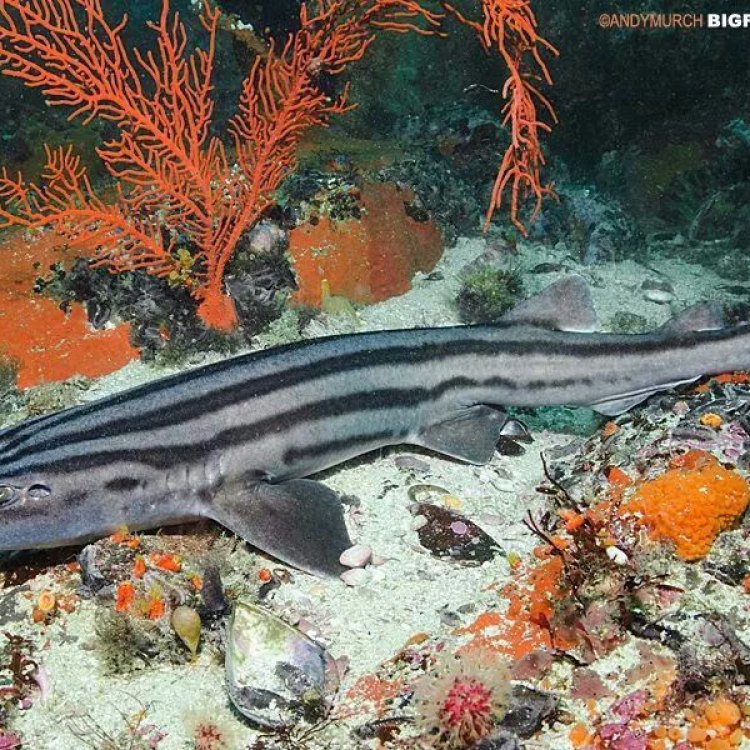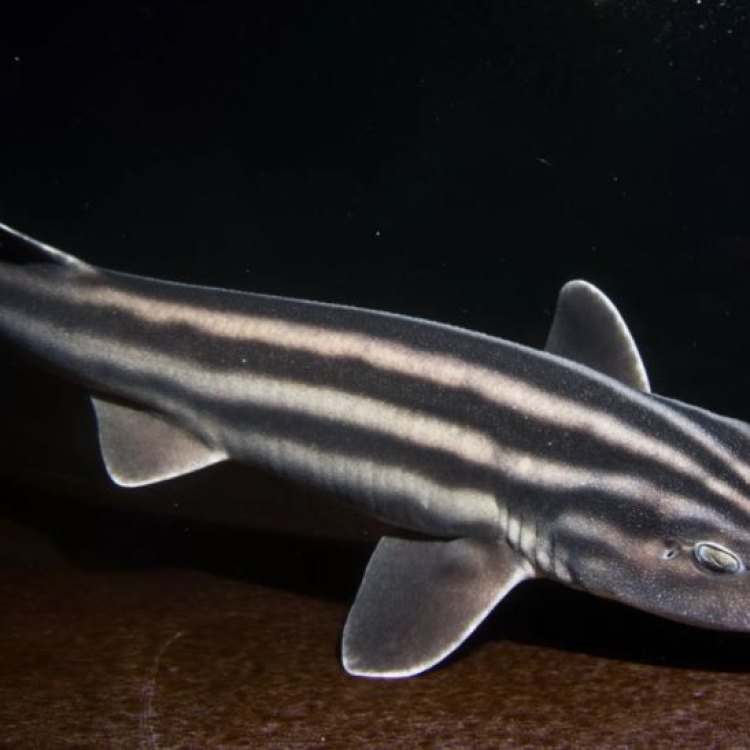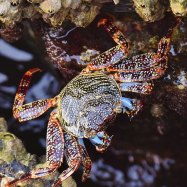
Pyjama Shark
Up to 1.5 meters
The Pyjama Shark, also known as the Striped Catshark, can grow up to 1.5 meters in length and is commonly found in KwaZulu-Natal and Western Cape. Belonging to the Scyliorhinidae family, this elongated and slender-bodied shark is a sight to behold. Keep an eye out for this stunning creature during your next diving adventure in South Africa! #PyjamaShark #StripedCatshark #SouthAfrica #Scyliorhinidae
Animal Details Summary:
Common Name: Pyjama Shark
Kingdom: Animalia
Habitat: Coastal waters
The Pyjama Shark: A Magnificent Creature Found in the Southeast Atlantic Ocean
The ocean is home to countless magnificent creatures, and among them is the Pyjama Shark, a unique and fascinating species that inhabits the Southeast Atlantic Ocean. With its scientific name Poroderma africanum, this shark is commonly known as the Pyjama Shark due to its distinct grey or brown body with dark bands, resembling the pattern of pajamas. But don't let its playful name fool you, for this animal is a powerful and skilled predator that has captured the hearts of many marine enthusiasts. In this article, we will delve deeper into the world of the Pyjama Shark, exploring its habitat, features, and behavior Pyjama Shark.Classified under the Animalia kingdom and Chordata phylum, the Pyjama Shark belongs to the Chondrichthyes class, which includes all cartilaginous fishes such as sharks, rays, and chimaeras. It belongs to the order Carcharhiniformes and the family Scyliorhinidae, which is home to over 150 species of catsharks. These sharks are found in coastal waters, mainly in the Southeast Atlantic Ocean, with its country of origin being South Africa. They can be observed in the KwaZulu-Natal and Western Cape regions, where the warm waters and diverse marine life provide the perfect environment for these creatures to thrive.
One of the most striking features of the Pyjama Shark is its coloration. As mentioned earlier, its body is grey or brown with dark bands, giving it a distinctive "pajama" look. This color pattern serves as camouflage, helping the shark blend in with the sandy ocean floor and avoid predators. The male and female sharks have slight differences in their coloration, with males being darker and having more defined bands. This difference can also be observed in their sizes, with males being slightly smaller than females Philippine Cobra.
In terms of physical appearance, the Pyjama Shark has an elongated and slender body, with a pointed snout and large eyes. Its mouth is filled with sharp, triangular teeth that aid in capturing prey. It also has five pairs of gill slits on the sides of its body, allowing it to respire while remaining stationary. These sharks have two dorsal fins, with the first one being larger and more triangular compared to the second, which is smaller and rounded. The Pyjama Shark also has two pelvic fins, an anal fin, and a caudal fin, which it uses to move swiftly through the water.
The average length of a Pyjama Shark is about one meter, with the maximum recorded length being 1.5 meters. They are considered a medium-sized shark, and their size plays a crucial role in their feeding habits. As carnivorous creatures, they primarily feed on small fish, crustaceans, and cephalopods. They are opportunistic hunters, meaning they will consume anything that comes in their way. However, they have been observed to have a particular preference for benthic species, those that live on or near the ocean floor.
Living in the coastal waters of South Africa, the Pyjama Shark's habitat consists of sandy and rocky areas, coral reefs, and kelp forests. They are nocturnal creatures, meaning they are most active at night, venturing out in search of prey. During the day, they can be found resting on the seabed, using their camouflage to remain undetected. Being bottom-dwellers, they are well-adapted to move along the ocean floor, utilizing their pelvic and caudal fins to navigate. This unique body shape also allows them to camouflage and ambush prey effectively.
Apart from their physical adaptations, the Pyjama Shark also has interesting behavioral traits that make them stand out in the marine world. They are solitary creatures and are usually found alone, except during the mating season. During this time, they display a unique behavior known as "pair swimming," where they swim in close proximity with their potential mate. This behavior is also observed during courtship, with the male frequently circling the female and showing his dominance.
The mating season for Pyjama Sharks begins in November and lasts until March, with peak mating occurring during December and January. After a successful mating, the female will lay a batch of eggs known as "mermaid's purses." These eggs have a distinctive spiral shape and are often found attached to kelp or other underwater structures. The female can lay up to 19 eggs at a time, with an incubation period of approximately 10 months. Once hatched, the juvenile sharks are fully independent and must fend for themselves.
Sadly, despite being a fascinating and unique species, the Pyjama Shark is facing threats to its survival. Habitat destruction, pollution, and overfishing are some of the major challenges faced by these creatures. As bottom-dwellers, they are often caught as bycatch in fishing nets, leading to a decline in their population. We must take action to protect and conserve these animals to ensure their survival.
In conclusion, the Pyjama Shark is a magnificent and captivating creature found in the Southeast Atlantic Ocean. From its distinct coloration and body shape to its fascinating behavior, this shark has captured the attention of many marine enthusiasts. But beyond its beauty, lies the need for conservation and protection. As we continue to explore and learn about the wonders of the ocean, let us also remember to do our part in preserving the remarkable creatures that call it their home.

Pyjama Shark
Animal Details Pyjama Shark - Scientific Name: Poroderma africanum
- Category: Animals P
- Scientific Name: Poroderma africanum
- Common Name: Pyjama Shark
- Kingdom: Animalia
- Phylum: Chordata
- Class: Chondrichthyes
- Order: Carcharhiniformes
- Family: Scyliorhinidae
- Habitat: Coastal waters
- Feeding Method: Carnivorous
- Geographical Distribution: Southeast Atlantic Ocean
- Country of Origin: South Africa
- Location: KwaZulu-Natal and Western Cape
- Animal Coloration: Grey or brown with dark bands
- Body Shape: Elongated and slender
- Length: Up to 1.5 meters

Pyjama Shark
- Adult Size: 1 - 1.3 meters
- Average Lifespan: 20 - 25 years
- Reproduction: Oviparous
- Reproductive Behavior: Males bite the female's pectoral fin during copulation
- Sound or Call: Unknown
- Migration Pattern: Migratory
- Social Groups: Solitary
- Behavior: Nocturnal and bottom-dwelling
- Threats: Overfishing and habitat degradation
- Conservation Status: Data Deficient
- Impact on Ecosystem: Keystone species
- Human Use: Commercial fishing and aquaria
- Distinctive Features: Distinctive dark bands on its body
- Interesting Facts: They use their strong pectoral fins to propel themselves over the seafloor.
- Predator: Larger sharks and marine mammals

Poroderma africanum
The Fascinating World of the Pyjama Shark: Uncovering the Secrets of an Enigmatic Species
In the vast and mysterious ocean, there are many creatures that have yet to be fully discovered and understood. Among these creatures is the pyjama shark, also known as the striped catshark or pajama catshark. This intriguing species of shark, with its distinctive dark bands and nocturnal behavior, has captured the curiosity of many marine enthusiasts and scientists alike. In this article, we will delve into the world of the pyjama shark and uncover its unique features, behavior, threats, and impact on the ecosystem PeaceOfAnimals.Com.Hailing from the depths of the southern and western coasts of South Africa, the pyjama shark is a striking species that can grow up to 1-1.3 meters in adult size. Its average lifespan is estimated to be around 20-25 years, making it a long-living and resilient species. But what truly sets this species apart from others is its distinctive dark bands that run vertically along its body, giving it a striking resemblance to the pajamas we wear to bed. These bands serve as a form of camouflage, helping the pyjama shark to blend in with its surroundings and remain hidden from predators.
One of the most intriguing aspects of the pyjama shark is its reproductive behavior. As an oviparous species, the female lays eggs that hatch after a period of 7-8 months. However, during copulation, the male pyjama shark exhibits an unusual behavior of biting the female's pectoral fin. This act is believed to be a way of mating control, ensuring that the female does not swim away during the fertilization process Pygmy Marmoset. This behavior has been observed in other shark species but is still not fully understood by scientists.
While there is not much information available about the sound or call of the pyjama shark, it is believed that they communicate using vibrations and movements. Their distinct markings and nocturnal behavior indicate that they rely heavily on sight and other senses to navigate and communicate in their environment.
Migration patterns of the pyjama shark are also not well-documented, but it is believed that they are a migratory species. Some individuals have been observed to migrate to deeper waters during colder months, while others remain in shallower areas all year round. This behavior is believed to be a way of avoiding adverse environmental conditions and finding adequate food sources.
Unlike other sharks that are known to live and hunt in groups, the pyjama shark is a solitary species. They spend most of their time at the bottom of the ocean, scavenging for food and hiding from predators. Their nocturnal behavior allows them to be more active and hunt during the cover of darkness, while also avoiding competition from other predators.
Despite their unique traits and behavior, pyjama sharks face a multitude of threats in their natural habitat. Overfishing, which involves catching more of a species than can be naturally replenished, is one of the most significant dangers to the pyjama shark population. Due to their slow reproductive rate, the pyjama shark is particularly vulnerable to overfishing, which can result in a decline in their population. Moreover, habitat degradation, especially in their nursery areas, is also a significant threat to this species. Human activities such as coastal development, pollution, and fishing practices that damage their habitat can have devastating effects on the pyjama shark population. If these threats are not addressed, it is estimated that the pyjama shark population could decline significantly in the near future.
Currently, the conservation status of the pyjama shark is listed as "Data Deficient" by the International Union for Conservation of Nature (IUCN). This means that there is not enough data available to accurately assess the status of their population. However, this does not mean that the species is not facing significant threats or that conservation efforts should not be implemented. It is crucial to gather more information and conduct further research on this species to provide a more accurate assessment and develop effective conservation strategies.
The pyjama shark plays a vital role in its ecosystem as a keystone species. As bottom-dwelling predators, they help regulate the population of their prey and maintain a healthy balance in the food chain. Additionally, their distinctive dark bands serve as a form of mimicry, making them a valuable target for predators such as larger sharks and marine mammals. Losing the pyjama shark from its ecosystem could have disastrous effects, leading to imbalances and disruptions in the entire marine environment.
Human use of the pyjama shark is primarily for commercial fishing and as a display in public aquariums. As mentioned earlier, overfishing poses a significant threat to this species, and it is crucial to regulate and monitor the catch of pyjama sharks to ensure their survival. Similarly, the capture and display of these sharks in aquariums should also be closely monitored to avoid any harm to the individuals or their natural habitats.
Aside from its distinctive bands and reproductive behavior, the pyjama shark also has fascinating physical adaptations. They have a large and powerful pectoral fin, which they use to propel themselves over the seafloor. This allows them to navigate and hunt with ease, despite being bottom-dwelling predators. Additionally, they have a strong and muscular tail that they use for quick bursts of speed when trying to catch prey or evade predators. These physical adaptations are critical for the survival of the pyjama shark and make them efficient and stealthy hunters in their environment.
In conclusion, the pyjama shark is an enigmatic and unique species that has captivated the interest of many. From its distinctive dark bands to its reproductive behavior and powerful physical adaptations, this species has a lot to offer in terms of its secrets and mysteries. Unfortunately, it also faces numerous threats, such as overfishing and habitat degradation, which could have severe consequences for its population and ecosystem. It is crucial to continue researching and studying this species to gather more information and develop effective conservation strategies. Only by understanding and protecting the pyjama shark can we ensure its survival and the balance of our marine ecosystems for generations to come.

The Pyjama Shark: A Magnificent Creature Found in the Southeast Atlantic Ocean
Disclaimer: The content provided is for informational purposes only. We cannot guarantee the accuracy of the information on this page 100%. All information provided here may change without prior notice.












